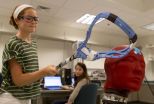(Press-News.org) Replenishing the supply of a molecule that normally activates cannabinoid receptors in the brain could relieve mood and anxiety disorders and enable some people to quit using marijuana, a Vanderbilt University study suggests.
Cannabinoid receptors are normally activated by compounds in the brain called endocannabinoids, the most abundant of which is 2-AG. They also are "turned on" by the active ingredient in marijuana.
Sachin Patel, M.D., Ph.D., and his colleagues developed a genetically modified mouse with impaired ability to produce 2-AG in the brain. The mice exhibited anxiety-like behaviors, and female mice also displayed behaviors suggestive of depression.
When an enzyme that normally breaks down 2-AG was blocked, and the supply of the endocannabinoid was restored to normal levels, these behaviors were reversed, the researchers reported on Nov. 26 in the online edition of the journal Cell Reports.
If further research confirms that some people who are anxious and depressed have low levels of 2-AG, this method of "normalizing 2-AG deficiency could represent a viable ... therapeutic strategy for the treatment of mood and anxiety disorders," they concluded.
However, this approach has not been tested in humans, they cautioned.
Relief of tension and anxiety is the most common reason cited for chronic marijuana use. Thus, restoring depleted levels of 2-AG also "could be a way to help people using marijuana," added Patel, the paper's senior author and professor of Psychiatry and of Molecular Physiology and Biophysics.
Chronic use of marijuana down-regulates cannabinoid receptors, and thus paradoxically increases anxiety. This can lead to a "vicious cycle" of increasing marijuana use that in some cases leads to addiction.
Patel and his colleagues previously have found cannabinoid receptors in the central nucleus of the amygdala of the mouse. The amygdala is a key emotional hub in the brain involved in regulating anxiety and the flight-or-fight response.
They also have found that chemically modified inhibitors of the COX-2 enzyme they developed relieve anxiety behaviors in mice by activating natural "endocannabinoids" without gastrointestinal side effects. Clinical trials of some of these potential drugs could begin in the next several years.
Cyclooxygenase (COX) enzymes produce pro-inflammatory prostaglandins and are the target of aspirin and other non-steroidal anti-inflammatory drugs (NSAIDs), used to relieve pain and inflammation. It has been known for several years that COX-2 inhibition also activates endocannabinoids.
INFORMATION:
The current study was led by first authors Brian Shonesy, Ph.D., research fellow in the lab of Roger Colbran, Ph.D., professor of Molecular Physiology and Biophysics, and Rebecca Bluett, a graduate student in Patel's lab.
The research was supported in part by National Institutes of Health grants MH065215, NS078291, MH0903412, MH100096, GM015431 and DA031572.
This research is being carried out under the auspices of MAGDRIVE, a European research project coordinated by Professor José Luis Pérez Díaz, from the UC3M Instituto Pedro San Juan de Lastanosa, in which seven European entities participate. It consists of the development of a magnetic gear reducer, that is, a mechanism that transforms speed from an input axle to another in an output axle (as in a bicycle chain mechanism or the gearbox of an automobile). But in this case, unlike a conventional gear reducer, this transmission is produced without contact between ...
Astronomers have measured the passing of a super-Earth in front of a bright, nearby Sun-like star using a ground-based telescope for the first time. The transit of the exoplanet 55 Cancri e is the shallowest detected from the ground yet. Since detecting a transit is the first step in analyzing a planet's atmosphere, this success bodes well for characterizing the many small planets that upcoming space missions are expected to discover in the next few years.
The international research team used the 2.5-meter Nordic Optical Telescope on the island of La Palma, Spain, a moderate-sized ...
December 1, 2014 - A study using intricate fiber dissection techniques provides new insights into the deep anatomy of the human brainstem--and helps to define "safe entry zones" for neurosurgeons performing brainstem surgery, according to a special article published in Operative Neurosurgery, a quarterly supplement to Neurosurgery, official journal of the Congress of Neurological Surgeons. These publications are published by Lippincott Williams & Wilkins, a part of Wolters Kluwer Health.
Neurosurgeons Dr. Kaan Yagmurlu and Dr. Albert L. Rhoton, Jr, of University of Florida, ...
Philadelphia, PA, December 1, 2014 - Panic disorder is a severe form of anxiety in which the affected individual feels an abrupt onset of fear, often accompanied by profound physical symptoms of discomfort. Scientists have known from studying twins that genes contribute to the risk of panic disorder, but very little is known about which specific genes are involved.
Two of the most common and terrifying symptoms of this severe anxiety are a sense of shortness of breath and feelings of suffocation. Studies have shown that breathing air that has increased levels of carbon ...
Mate choice is often the most important decision in the lives of humans and animals. Scientists at the Konrad Lorenz Institute of Ethology at the Vetmeduni Vienna have found the first evidence that birds may choose their mate through odor. They published their findings in Nature's Scientific Reports.
It has long been understood that reproducing with close relatives may have profoundly negative effects on offspring. It is therefore not surprising that biologists have discovered in some species that breeding individuals have evolved ways to detect their genetic similarity ...
Current data bases hold information on thousands of molecules--including drugs, natural substances, and chemical agents found in the environment-- that are associated with diseases, either because they have adverse effects or exert a therapeutic action. Using this information, gathered over many years and available in data bases, scientists headed by ICREA researcher Patrick Aloy at the Institute for Research in Biomedicine (IRB Barcelona) have devised a predictive model that allows them to associate chemical fragments with positive or negative effects in 20% of human ...
Athens, Ga. - Debunking the myth of the "mean girl," new research from the University of Georgia has found that boys use relational aggression--malicious rumors, social exclusion and rejection--to harm or manipulate others more often than girls.
The longitudinal study, published online in the journal Aggressive Behavior, followed a cohort of students from middle to high school and found that, at every grade level, boys engaged in relationally aggressive behavior more often than girls.
A team led by UGA professor Pamela Orpinas analyzed data collected from 620 students ...
PROVIDENCE, R.I. [Brown University] -- Lacrosse players swing hard, which is why errant stick blows are the leading cause of concussion in girls' and women's lacrosse. In a new study, researchers measured how much the worst blows accelerate the head and how much different kinds of headgear could reduce those accelerations.
Girls' and women's lacrosse is a different game from the version played by males, said Joseph Crisco, the Henry Frederick Lippitt Professor of Orthopaedic Research in the Alpert Medical School of Brown University and a researcher at Rhode Island Hospital. ...
A DRUG that could reduce the harmful side-effects of 'binge drinking', especially by teenagers, has been successfully developed and tested by a team of European scientists, including the University of Huddersfield's Professor Mike Page and Dr Karl Hemming. There is also the potential for new ways to treat Alzheimer's and other neurological diseases that damage the brain.
The key to the breakthrough is a compound developed by Professor Page and colleagues at the University of Huddersfield which is named ethane-beta-sultam. This is a taurine 'pro-drug' - an effective ...
Knowledge of the three-dimensional structures of proteins is essential for understanding biological processes.
Structures help to explain molecular and biochemical functions, visualize details of macromolecular interactions, facilitate understanding of underlying biochemical mechanisms and define biological concepts.
The human genome and follow-up sequencing projects have revolutionized biology and medicine; structural genomic programmes have developed and applied structure-determination pipelines to a wide range of protein targets, facilitating the visualization of ...





